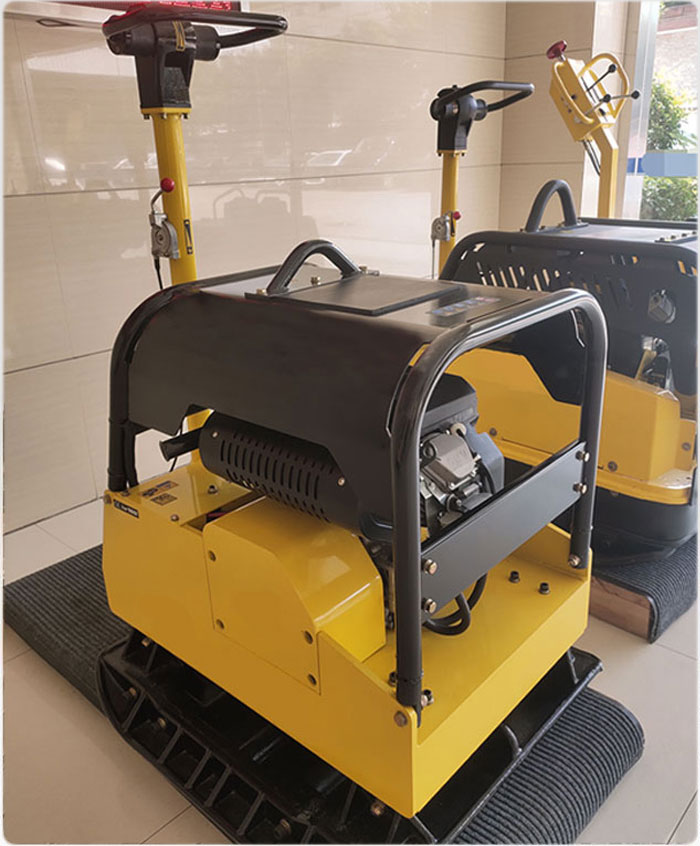Heavy Duty Compactor Breakdown: 7 Reasons It’s a Jobsite Game-Changer
Home » Heavy Duty Compactor Breakdown: 7 Reasons It’s a Jobsite Game-Changer

Table of Contents
Introduction to Heavy Duty Compactors
What Is a Heavy Duty Compactor?
A heavy duty compactor is a construction machine used to compress soil, gravel, asphalt, or other surfaces into a more solid and stable foundation. These machines are essential in building roads, walkways, driveways, and landscaping areas. Whether it’s a handheld plate compactor or a walk-behind roller, their purpose is singular: maximize ground density for long-lasting structural integrity.
Common Uses in Construction
Preparing soil for concrete pours
Compacting asphalt for roads and parking lots
Tamping trenches for utilities
Stabilizing paver bases in landscaping
In short, if the ground needs to be solid—you need a compactor.
Types of Heavy Duty Compactors
Understanding your equipment options helps you match the right tool to the task.
Plate Compactors
These machines use a vibrating metal plate to exert pressure on the ground. They’re ideal for granular soils like sand and gravel. Plate compactors come in forward and reversible models, depending on the area and depth of compaction needed.
Jumping Rammers
Perfect for cohesive soils such as clay, jumping rammers deliver a pounding force that “jumps” up and down. Though smaller, they’re highly effective for narrow trenches and tight corners.
Road Rollers
These large machines use drum rollers to compact vast surfaces—typically for roads, highways, and airport runways. Many walk-behind rollers feature hydraulic drive systems for smooth, controlled operation.
1. Exceptional Compaction Power
How Force Impacts Soil Stability
The compaction force—measured in kilonewtons (kN)—determines how well the soil resists shifting. A model delivering 30 kN or more can stabilize deeply layered foundations, essential for heavy-load applications.
Applications for High-Capacity Models
Road base compaction
Driveways with frequent vehicle traffic
Industrial warehouse floors
These machines are more than just strong—they create the reliable foundation your structure needs.
2. Increased Productivity on the Jobsite
Faster Coverage
Heavy duty compactors can compact more square meters per hour compared to manual or light-duty alternatives. This translates to quicker project completion, a major advantage in both commercial and residential settings.
Reduced Manual Labor
Advanced models reduce the physical strain on workers thanks to features like:
Self-propelling systems
Ergonomic handle designs
Low-vibration technology
Better productivity = faster ROI.
3. Versatility Across Applications
Asphalt, Gravel, and Soil
One machine can do it all. Heavy duty compactors are multi-surface compatible, allowing you to work with:
Wet clay
Dry sand
Fine gravel
Hot asphalt
Landscaping to Roadwork
Whether you’re installing a backyard patio or prepping a new urban roadway, a single compactor can adapt to the task.
4. Built to Withstand Rugged Conditions
Durable Frames and Engines
Top-tier models use steel-reinforced chassis, corrosion-resistant paint, and commercial-grade engines like Honda or Loncin. These features ensure they run strong—even under the toughest jobsite conditions.
Weather Resistance
Designed for both rain and shine, many models come with sealed electrical systems and weatherproof fuel tanks, reducing downtime due to environmental factors.
5. Operator-Friendly Design
Vibration Dampening
Low-vibration handles prevent hand-arm fatigue, keeping the operator comfortable and productive for longer shifts.
Easy-to-Use Controls
One-touch ignition systems
Adjustable throttle
Foldable handles for storage
These features make compactors user-friendly, even for less experienced crews.
6. Fuel-Efficient and Eco-Conscious Options
Electric vs. Gasoline vs. Diesel Models
Electric compactors are ideal for indoor or emission-sensitive jobs, while gas and diesel offer maximum runtime and power for larger projects.
| Fuel Type | Best For | Emissions | Runtime |
|---|---|---|---|
| Electric | Indoor use, light-duty jobs | None | Limited |
| Gasoline | General construction | Medium | Long |
| Diesel | Industrial use | Low (modern engines) | Longest |
Low Emissions Benefits
Newer engines comply with Tier IV and Euro V standards, reducing CO₂ and NOx output, which is better for the environment and regulatory compliance.
7. Long-Term Cost Savings
Lower Maintenance Costs
Heavy duty compactors are engineered for durability, meaning fewer repairs and lower replacement costs over time. Many models feature:
Cast iron base plates that resist warping
Low-maintenance engines with accessible service points
Sealed bearings to prevent dust and debris infiltration
Routine maintenance like oil changes, air filter cleaning, and plate inspection can extend a machine’s life well past 5–7 years—making it a smart long-term investment.
Higher ROI
When you factor in the extended lifespan, lower fuel consumption, and reduced labor needs, your compactor can pay for itself within the first few major projects. Renting equipment repeatedly becomes more expensive over time compared to owning a reliable machine.
Choosing the Right Heavy Duty Compactor
Factors to Consider
Choosing the best compactor for your job depends on:
Surface type: Asphalt, soil, gravel, or mixed materials
Compaction depth required
Project size and frequency
Mobility needs (reversible, forward, or walk-behind)
Brand and Model Comparisons
Here’s a quick breakdown of popular brands and what they’re known for:
| Brand | Known For | Ideal For |
|---|---|---|
| Wacker Neuson | Advanced vibration tech | Pro contractors |
| Honda (Engine) | Fuel efficiency, reliability | Mid-to-large projects |
| DIMEC(PME) | Compact design, trench work | Residential & light commercial |
| Loncin | Budget-friendly, powerful | Entry-level or mixed-use |
Always review warranty coverage, spare parts availability, and dealer support before purchasing.
Safety Considerations When Using Compactors
PPE and Safe Handling
Operating a compactor may seem straightforward, but safety should always be a top priority. Key safety equipment includes:
Anti-vibration gloves
Steel-toe boots
Hearing protection
Dust masks (for dry soil conditions)
Training Recommendations
Ensure operators are trained on:
Starting and stopping procedures
Emergency shut-off functionality
Recognizing signs of equipment wear or damage
Navigating inclines and declines safely
Providing on-site equipment training significantly reduces risk of injury and downtime.
Maintenance Tips for Longevity
Proper care keeps your compactor running like new. Follow this schedule for best results:
Daily Checklist
Inspect engine oil level
Clean or tap air filter
Check for fuel or oil leaks
Tighten visible bolts
Weekly Checklist
Inspect vibration isolators and springs
Lubricate pivot points
Flush water tank (if applicable)
Monthly Checklist
Change oil (per manufacturer specs)
Replace or deep-clean air filter
Inspect drive belts for wear
Check throttle cable tension
Storage and Offseason Care
If storing for more than 30 days:
Drain fuel or add stabilizer
Remove spark plug and apply fogging oil
Store in dry, covered area
These simple steps can add years to your equipment’s life.
Real-World Case Studies
Urban Construction Projects
In downtown Chicago, a contractor used a reversible plate compactor with 30 kN of force for alley restoration. The compact machine allowed the team to complete the job 25% faster than using manual tampers and light-duty units.
Rural Infrastructure Builds
In Southeast Asia, a local municipality deployed diesel-powered walk-behind road rollers to compact soil and gravel on village roads. These units ran for 12+ hours a day in extreme humidity and proved more cost-effective than imported alternatives.
Each of these examples shows how choosing the right heavy duty compactor improves productivity, cost-efficiency, and surface longevity.
Frequently Asked Questions
1. What is the ideal compaction depth for a plate compactor?
Most plate compactors can achieve compaction depths of 10 to 30 cm, depending on soil type and model specifications. For deeper layers, multiple passes or heavier equipment may be required.
2. Can I use a heavy duty compactor on wet soil?
Yes, but with caution. Wet clay or saturated soil can reduce compaction efficiency and damage the surface. Let soil dry to a damp consistency for best results.
3. How do I know when soil is fully compacted?
Use a Proctor test or dynamic cone penetrometer to measure soil density. Alternatively, if the soil stops visibly moving after repeated passes, it’s likely well compacted.
4. Do electric compactors perform as well as gas models?
Electric models are great for indoor or small-scale projects and produce zero emissions. However, they generally lack the compaction force and runtime of gas or diesel counterparts.
5. How often should I service my compactor?
Follow the manufacturer’s schedule, but a general rule is:
Oil changes every 25–50 hours
Air filter check weekly
Full inspection monthly
6. Are there any regulations for using compactors in urban areas?
Yes. Some cities require low-noise and low-emission machines for residential zones. Always check local environmental and zoning laws before operating.
Conclusion: Why a Heavy Duty Compactor Is Worth It
Investing in a heavy duty compactor is one of the smartest decisions for any construction, landscaping, or infrastructure-focused business. Whether you’re working with clay-heavy trenches, sub-base for roads, or paver-ready gravel pads, the compactor ensures structural integrity, long-term savings, and efficient project turnover.
Choosing the right model—paired with proper maintenance and training—means you’ll get maximum performance for years to come.
For high-quality, professional-grade compactors, consider exploring suppliers like DIMEC or contacting trusted local dealers.
Small Construction Equipment Specialist
About the author

Amber Lu
General Manager | Wuxi Pinnacle Mechanical Equipment Co., Ltd. (PME)
Specialist in Compact Construction Machinery & International Trade
As General Manager of PME, I bring over 15 years of expertise in compact construction machinery and global trade. I have worked extensively with medium to large companies worldwide, providing professional support and customized solutions across diverse markets.
With in-depth product knowledge of plate compactors, tamping rammers, floor saws, concrete vibrators, engines, and power equipment, I lead PME’s international expansion and customer service strategy. My experience covers the full trade process—from pre-sales consultation and order coordination to after-sales service—ensuring efficiency and customer satisfaction.
Backed by a skilled technical team and complete in-house production capabilities, I am committed to driving product quality, innovation, and long-term partnerships across more than 68 countries.
You May Also Like
